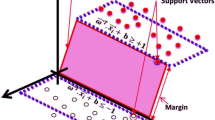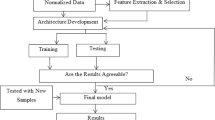Abstract
The main objective of the proposed methodology is to classify an ECG signal as normal or abnormal using the optimal neuro-fuzzy classifier. The proposed work consists of two phases namely, feature extraction and neuro-fuzzy classifier based classification. The beat signals are initially taken from the physio-bank ATM. Then, three types of features are extracted from each signal namely, Morphological-based features, Haar wavelet-based features, and Tri-spectrum based features. After feature extraction, the optimal neuro-fuzzy classifier is classifying the beat signal as normal or abnormal. Here, Artificial Bee Colony (ABC) algorithm is combined with Genetic Algorithm (GA) for training the neuro-fuzzy classifier. For experimental evaluation, the MIT-BIH Arrhythmia Database is utilized and the performances are analyzed in terms of accuracy, sensitivity, and specificity. The experimental results clearly demonstrated that the proposed technique outperformed by having better accuracy of 93% when compared existing technique achieved 84% only.










Similar content being viewed by others
References
Aramendi E, Irusta U, Pastor E, Bodegas A, Benito F (2010) ECG spectral and morphological parameters reviewed and updated to detect adult and paediatric life-threatening arrhythmia. Physiol Meas 31(6):749
Bianchi D, Michele PD, Marchetti C, Tirozzi B, Cuomo S, Marie H, Migliore M (2014) Effects of increasing CREB-dependent transcription on the storage and recall processes in a hippocampal CA1 microcircuit. Hippocampus 24(2):165–177
Carnevale L, Celesti A, Fazio M, Bramanti P, Villari M (2017) Heart disorder detection with menard algorithm on apache spark, in: European Conference on Service-Oriented and Cloud Computing, Springer, pp. 229–237
Chen S, Hua W, Li Z, Li J, Gao X (2017) Heartbeat classification using projected and dynamic features of ECG signal. Biomed Signal Process Control 31:165–173. https://doi.org/10.1016/j.bspc.2016.07.010
Cuomo S, De Pietro G, Farina R, Galletti A, Sannino G (2016) A revised scheme for real time ecg signal denoising based on recursive filtering. Biomed Signal Process Control 27:134–144
Das M, Ari S (2014) ECG beats classification using mixture of features. Int Sch Res Not: 1–12, 2014
Dong X, Wang C, Si W (2017) ECG beat classification via deterministic learning. Neurocomputing 240:1–12
Fang R, Pouyanfar S, Yang Y, Chen S-C, Iyengar S (2016) Computational health informatics in the big data age: A survey. ACM Comput Surv 49:1) 12
Feng N, Xu S, Liang Y, Liu K (2019) A Probabilistic Process Neural Network and Its Application in ECG Classification. IEEE Access 7:50431–50439
Géron A (2017) Hands-on Machine Learning with Scikit-Learn and Tensorflow: Concepts, Tools, and Techniques to Build Intelligent Systems. OReilly Media, Sebastopol
Hanbay K (2019) Deep neural network based approach for ECG classification using hybrid differential features and active learning. IET Signal Processing 13(2):165–175
Huang H, Liu J, Zhu Q, Wang R, Hu G (2014) A new hierarchical method for interpatient heartbeat classification using random projections and RR intervals. Biomed Eng Online 13:1–26. https://doi.org/10.1186/1475-925X-13-90
Isafiade OE, Isafiade OE, Bagula AB (2016) Data Mining Trends and Applications in Criminal Science and Investigations, first edn. IGI Global, Hershey, pp 1–386
Kanaujia M, Srivastava G (2015) ECG signal decomposition using PCA and ICA. In: National Conference on Recent Advances in Electronics & Computer Engineering (RAECE)
Lee J, Kwak K (2019) Personal Identification Using a Robust Eigen ECG Network Based on Time-Frequency Representations of ECG Signals. IEEE Access 7:48392–48404
Liamedo M, Martinez J (2012) P.: ‘An automatic patient-adapted ECG heartbeat classifier allowing expert assistance. IEEE Trans Biomed Eng 59(8):2312–2320
Llamedo M, Martínez JP (2011) Heartbeat classification using feature selection driven by database generalization criteria. IEEE Trans Biomed Eng 58:616–625. https://doi.org/10.1109/TBME.2010.2068048
Mar T, Zaunseder S, Martnez JP, Llamedo M, Poll R (2011) Optimization of ECG classification by means of feature selection. IEEE Trans Biomed Eng 58:2168–2177. https://doi.org/10.1109/TBME.2011.2113395
Martis RJ, Acharya UR, Mandana KM, Ray AK, Chakraborty C (2012) Application of principal component analysis to ECG signals for automated diagnosis of cardiac health. Expert Syst Appl 39:11792–11800
Melillo P, Castaldo R, Sannino G, Orrico A, De Pietro G, Pecchia L (2015) Wearable technology and ECG processing for fall risk assessment, prevention and detection. In: 37th Annual International Conference of the IEEE Engineering in Medicine and Biology Society, EMBC, pp. 7740–7743
Sannino G, De Pietro G (2011) An evolved ehealth monitoring system for a nuclear medicine department, In: Developments in E-systems Engineering (DeSE), IEEE, pp. 3–6
Sannino G, De Pietro G (2018) A deep learning approach for ECG-based heartbeat classification for arrhythmia detection. Futur Gener Comput Syst 86:446–455
Sarfraz M, Khan A, Li F (2014) Using independent component analysis to obtain feature space for reliable ECG Arrhythmia classification. In: IEEE international conference on bioinformatics and biomedicine (BIBM)
Shi HT, Wang HR, Huang YX, Zhang YF, Liu CL (2017) A Mobile Intelligent ECG Monitoring System Based on IOS. International Conference on Sensing, Diagnostics, Prognostics, and Control:149–153
Shi H, Wang H, Huang Y, Zhao L, Qin C, Liu C (2019) A hierarchical method based on weighted extreme gradient boosting in ECG heartbeat classification. Comput Methods Prog Biomed 171:1–10
Silva I, Moody GB (2014) An open-source toolbox for analysing and processing physionet databases in matlab and octave. J Open Res Softw 2:1) e27
J. Sun, C.K. Reddy (2013) Big data analytics for healthcare. In: Proceedings of the 19th ACM SIGKDD international conference on Knowledge discovery and data mining, ACM, 1525–1525
Tripathy R, Bhattacharyya A, Pachori R (2019) A Novel Approach for Detection of Myocardial Infarction From ECG Signals of Multiple Electrodes. IEEE Sensors J 19(12):4509–4517
Ye C, Kumar BV, Coimbra MT (2012) Heartbeat classification using morphological and dynamic features of ECG signals. IEEE Trans Biomed Eng 59(10):2930–2941
Zhu W, Chen X, Wang Y, Wang L (2019) Arrhythmia Recognition and Classification Using ECG Morphology and Segment Feature Analysis. IEEE/ACM Transactions on Computational Biology and Bioinformatics 16(1):131–138
Author information
Authors and Affiliations
Corresponding author
Additional information
Publisher’s note
Springer Nature remains neutral with regard to jurisdictional claims in published maps and institutional affiliations.
Rights and permissions
About this article
Cite this article
Muthuvel, K., Anto, S. & Alexander, T.J. GABC based neuro-fuzzy classifier with hybrid features for ECG Beat classification. Multimed Tools Appl 78, 35351–35372 (2019). https://doi.org/10.1007/s11042-019-08132-9
Received:
Revised:
Accepted:
Published:
Issue Date:
DOI: https://doi.org/10.1007/s11042-019-08132-9




